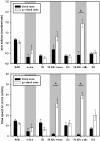Ultrasonic communication in rats: can playback of 50-kHz calls induce approach behavior?
- PMID: 18159248
- PMCID: PMC2137933
- DOI: 10.1371/journal.pone.0001365
Ultrasonic communication in rats: can playback of 50-kHz calls induce approach behavior?
Abstract
Rats emit distinct types of ultrasonic vocalizations, which differ depending on age, the subject's current state and environmental factors. Since it was shown that 50-kHz calls can serve as indices of the animal's positive subjective state, they have received increasing experimental attention, and have successfully been used to study neurobiological mechanisms of positive affect. However, it is likely that such calls do not only reflect a positive affective state, but that they also serve a communicative purpose. Actually, rats emit the highest rates of 50-kHz calls typically during social interactions, like reproductive behavior, juvenile play and tickling. Furthermore, it was recently shown that rats emit 50-kHz calls after separation from conspecifics. The aim of the present study was to test the communicative value of such 50-kHz calls. In a first experiment, conducted in juvenile rats situated singly on a radial maze apparatus, we showed that 50-kHz calls can induce behavioral activation and approach responses, which were selective to 50-kHz signals, since presentation of 22-kHz calls, considered to be aversive or threat signals, led to behavioral inhibition. In two other experiments, we used either natural 50-kHz calls, which had been previously recorded from other rats, or artificial sine wave stimuli, which were identical to these calls with respect to peak frequency, call length and temporal appearance. These signals were presented to either juvenile (Exp. 2) or adult (Exp. 3) male rats. Our data clearly show that 50-kHz signals can induce approach behavior, an effect, which was more pronounced in juvenile rats and which was not selective to natural calls, especially in adult rats. The recipient rats also emitted some 50-kHz calls in response to call presentation, but this effect was observed only in adult subjects. Together, our data show that 50-kHz calls can serve communicative purposes, namely as a social signal, which increases the likelihood of approach in the recipient conspecific.
Conflict of interest statement
Figures








References
-
- Constantini F, D'Amato F. Ultrasonic vocalizations in mice and rats: social contexts and functions. Acta Zool Sinica. 2006;52:619–633.
-
- Knutson B, Burgdorf J, Panksepp J. Ultrasonic vocalizations as indices of affective states in rats. Psychol Bull. 2002;28:961–977. - PubMed
-
- Portfors CV. Types and functions of ultrasonic vocalizations in laboratory rats and mice. J Am Assoc Lab Anim Sci. 2007;46:28–34. - PubMed
-
- Hofer MA. Multiple regulators of ultrasonic vocalization in the infant rat. Psychoneuroendocrinology. 1996;21:203–217. - PubMed
-
- Blanchard RJ, Blanchard DC, Agullana R, Weiss SM. Twenty-two kHz alarm cries to presentation of a predator, by laboratory rats living in visible burrow systems. Physiol Behav. 1991;50:967–72. - PubMed
Publication types
MeSH terms
LinkOut - more resources
Full Text Sources
Miscellaneous

